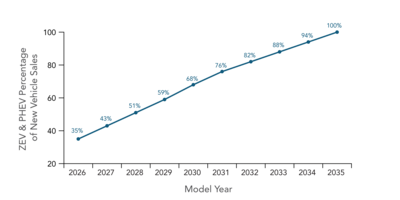Toyota (the last best chance to stop the EV fairy-tale) folded like an origami chicken and facilitated the elimination of freedom of choice by agreeing to stop selling real cars in California after 2035. Cluck cluck
 |
Co-publishers Opinion: This surrender will open the door for Chinese Car Makers to own California (and the world's) car sales forever. The Commies Have Won...Choice In America Will Be Just A Good Memory - Up Theirs! Let me know what you think...bgordon@theautochannel.com
- What Happened To: "Motorist Choice Is The Future, The enemy is carbon, not internal combustion engines" Akio Toyoda How Could You Allow This To Happen, when Toyota Holds All The Cards?
- SEE ALSO: CARB, GM, SoCal Edison and Others Join Forces to Keep California in the Lead of the Great EV Scam
Toyota’s Statement on Its Alignment with CARB and the State of California on GHG Reduction and Carbon Neutrality Goals
"Toyota continues to share the vision of GHG reduction and carbon neutrality goals with CARB and the State. In our recent communication, we acknowledged CARB’s leadership in climate policies and its authority to set vehicle emissions standards under the Clean Air Act. We are also excited about our efforts to extend zero-emissions activities beyond our core vehicle business with our “Clean Ports, Clean Corridors and Clean Communities” initiative, and we’re eager to explore the State’s engagement with these efforts."
SACRAMENTO - The California Air Resources Board today approved the trailblazing Advanced Clean Cars II rule that sets California on a path to rapidly growing the zero-emission car, pickup truck and SUV market and deliver cleaner air and massive reductions in climate-warming pollution.
The rule establishes a year-by-year roadmap so that by 2035 100% of new cars and light trucks sold in California will be zero-emission vehicles, including plug-in hybrid electric vehicles. The regulation realizes and codifies the light-duty vehicle goals set out in Governor Newsom’s Executive Order N-79-20.
“Once again California is leading the nation and the world with a regulation that sets ambitious but achievable targets for ZEV sales. Rapidly accelerating the number of ZEVs on our roads and highways will deliver substantial emission and pollution reductions to all Californians, especially for those who live near roadways and suffer from persistent air pollution,” said CARB Chair Liane Randolph. “The regulation includes ground-breaking strategies to bring ZEVs to more communities and is supported by the Governor’s ZEV budget which provides incentives to make ZEVs available to the widest number of economic groups in California, including low- and moderate-income consumers.”
Many states and nations have set targets and goals to phase out the sale of internal combustion cars. California’s is the most aggressive regulation to establish a definitive mechanism to meet required zero-emission vehicle (ZEV) sales that ramp up year over year, culminating in 100% ZEV sales in 2035. The timeline is ambitious but achievable: by the time a child born this year is ready to enter middle school, only zero-emission vehicles or a limited number of plug-in hybrids (PHEVs) will be offered for sale new in California. The regulation also includes provisions that enhance equity in the transition to zero-emission vehicles and provides consumers certainty about the long-term emission benefits, quality, and durability of these clean cars and trucks and the batteries they run on.
Clean Air and Climate Benefits
Transportation is the single largest source of global warming emissions and air pollution in the state. This nation-leading regulation slashes emissions from cars and light trucks.
By 2037, the regulation delivers a 25% reduction in smog-causing pollution from light-duty vehicles to meet federal air quality standards. This benefits all Californians but especially the state’s most environmentally and economically burdened communities along freeways and other heavily traveled thoroughfares. From 2026 through 2040 the regulation will result in cumulative avoided health impacts worth nearly $13 billion including 1,290 fewer cardiopulmonary deaths, 460 fewer hospital admissions for cardiovascular or respiratory illness, and 650 fewer emergency room visits for asthma.
The regulation delivers multiple benefits that grow year by year. By 2030, there will be 2.9 million fewer new gas-powered vehicles sold, rising to 9.5 million fewer conventional vehicles by 2035. In 2040, greenhouse gas emissions from cars, pickups, and SUVs are cut in half, and from 2026 through 2040 the regulation cuts climate warming pollution from those vehicles a cumulative total of 395 million metric tons. That is equivalent to avoiding the greenhouse gases produced from the combustion of 915 million barrels of petroleum.
General requirements
The new regulation accelerates requirements that automakers deliver an increasing number of zero-emission light-duty vehicles each year beginning in model year 2026. Sales of new ZEVs and PHEVs will start with 35% that year, build to 68% in 2030, and reach 100% in 2035.
Eligibility and Credits
The regulation applies to automakers (not dealers) and covers only new vehicle sales. Itdoes not impact existing vehicles on the road today, which will still be legal to own and drive.
Plug-in hybrid, full battery-electric and hydrogen fuel cell vehicles count toward an automaker’s requirement. PHEVs must have an all-electric range of at least 50 miles under real-world driving conditions. In addition, automakers will be allowed to meet no more than 20% of their overall ZEV requirement with PHEVs.
Battery-electric and fuel cell vehicles will need a minimum range of 150 miles to qualify under the program, include fast-charging ability and come equipped with a charging cord to facilitate charging, and meet new warranty and durability requirements.
Enhanced Durability and Warranty Requirements
The new regulation also takes regulatory steps to assure that ZEVs can be full replacements to gasoline vehicles, hold their market value for owners, and that used car buyers are getting a quality vehicle that will not pollute.
By model year 2030, the rules require the vehicle to maintain at least 80% of electric range for 10 years or 150,000 miles. (Phased in from 70% for 2026 through 2029 model year vehicles.) By model year 2031, individual vehicle battery packs are warranted to maintain 75% of their energy for eight years or 100,000 miles. (Phased in from 70% for 2026 through 2030 model years.) ZEV powertrain components are warranted for at least three years or 50,000 miles.
Environmental Justice
As noted, the regulation delivers substantial emission reductions to all Californians, with particular benefits to those who live near roadways and suffer from persistent air pollution. The durability and warranty requirements in the regulation will help establish a viable and dependable used ZEV market to ensure the emission benefits are permanent, and the regulation includes an approach that provides credits to automakers for certain actions that increase access to ZEVs by low-income households and people living in disadvantaged communities.
Increasing Access to Zero-Emission Vehicles for all Californians
Governor Newsom proposed, and the Legislature has approved, $2.7 billion in fiscal year 2022-23, and $3.9 billion over three years, for investment in ZEV adoption, as well as clean mobility options for California’s most environmentally and economically burdened communities. These programs support the new regulation by increasing access to ZEVs for all Californians, including moderate- and low-income consumers. They include:
- Clean Cars 4 All provides up to $9,500 to low-income drivers who scrap their older vehicles and want to purchase something that runs cleaner.
- The Clean Vehicle Rebate Project (CVRP) provides up to $7,000 for income-qualified drivers to buy or lease a ZEV.
- The Clean Vehicle Assistance Program provides low-income car buyers with special financing and up to $5,000 in down-payment assistance.
The Governor’s ZEV budget includes $400 million over three years for the statewide expansion of Clean Cars 4 All and for a suite of clean transportation equity projects. The budget also includes $525 million for the Clean Vehicles Rebate Project (CVRP). In addition, there is $300 million for more charging infrastructure, especially for those consumers who may not have a garage where they can charge their EV.
Consumer Savings
Drivers of full battery-electric vehicles already save money on operation and maintenance compared to cars with internal combustion engines. That’s the result of cheaper fuel — charging at home costs about half as much as gasoline for the same number of miles driven — and battery-electric vehicles can save drivers 40% in maintenance costs.
CARB analysis indicates that battery-electric vehicles are likely to reach cost parity with conventional vehicles by 2030. By 2035, consumers are likely to realize as much as $7,900 in maintenance and operational savings over the first 10 years of ownership. Owners will also see 10-year savings from 2026 model year battery-electric vehicles, though not quite as much.
Stringent Standards for Conventional Cars
As with the original Advanced Clean Cars rules, ACC II includes updated regulations for light- and medium-duty internal combustion engine vehicles as well, to mitigate the air quality impacts from conventional vehicles. These low-emission vehicle standards help deliver real-world emission benefits that complement more significant emission reductions gained by wider ZEV deployment. This will prevent potential emission backsliding by removing ZEVs from the emissions baseline used to calculate new vehicle fleet-average emissions. The regulation also reduces the allowable exhaust emissions under more real-world driving conditions and emissions caused by evaporation.
Background
Transportation is responsible for approximately 50% of greenhouse gas emissions (when accounting for fuel production emissions) and 80% of air pollutants in California.
The ACC II regulation is phase two of the Advanced Clean Cars Program, originally adopted by CARB in 2012. The regulation was designed to bring together CARB’s passenger vehicle requirements to meet federal air quality standards and also support California’s AB 32 statute to develop and implement programs to reduce greenhouse gas emissions back down to 1990 levels by 2020, a goal achieved in 2016 as a result of numerous greenhouse gas emissions mitigation programs.
The ACC II regulation is a major tool in the effort to reach the SB 32 target of reducing greenhouse gases an additional 40% below 1990 levels by 2030, while also achieving Governor Newsom’s 2035 target for ending sales of new internal-combustion engine passenger vehicles. Ending sales of vehicles powered by fossil fuels is a critical element in the state’s efforts to achieve carbon neutrality by 2045 or sooner.
Other States
States that currently follow California’s vehicle rules are expected to adopt these regulations through their own rulemakings, gaining the clean air and climate benefits the regulation delivers. These states constitute about 40% of the nation’s new car sales.
CARB's mission is to promote and protect public health, welfare, and ecological resources through effective reduction of air pollutants while recognizing and considering effects on the economy. CARB is the lead agency for climate change programs and oversees all air pollution control efforts in California to attain and maintain health-based air quality standards.


